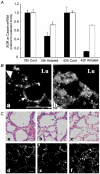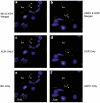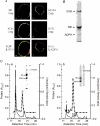Functional regulation of xanthine oxidoreductase expression and localization in the mouse mammary gland: evidence of a role in lipid secretion
- PMID: 12456835
- PMCID: PMC2290700
- DOI: 10.1113/jphysiol.2002.027185
Functional regulation of xanthine oxidoreductase expression and localization in the mouse mammary gland: evidence of a role in lipid secretion
Abstract
Xanthine oxidoreductase (XOR), a key enzyme of purine metabolism, has been implicated in the secretion of the milk fat droplet in lactating mammary epithelial cells, possibly through structural interactions with other milk fat globule proteins including butyrophilin (Btn) and adipophilin (ADPH). To help determine the mechanism by which XOR is regulated, we examined the expression and localization of XOR in the non-secretory states of late pregnancy and induced involution compared with the state of active secretion. XOR mRNA levels started to increase at mid-pregnancy, turned sharply upwards at the onset of lactation and decreased rapidly with forced involution, indicating transcriptional control of the enzyme level by differentiation and secretory function. During pregnancy and involution the enzyme was diffusely distributed in the cytoplasm, but moved rapidly to the apical membrane of the cells when secretion was activated, where it colocalized with both Btn and ADPH, similar to the situation in the milk fat globule itself. Size-exclusion chromatography of solubilized milk fat globule membrane proteins showed that XOR formed a sulphydryl-bond-dependent complex with Btn and ADPH in the milk fat globule membrane. XOR returned to a diffuse cytoplasmic localization shortly after induced involution, while Btn remained localized to the apical membrane, suggesting that localization of XOR is not dependent on the presence of Btn in the apical membrane. Our findings indicate that the expression and membrane association of XOR in the mammary gland are tightly regulated by secretory activity, and suggest that the apical membrane association of XOR regulates the coupling of lipid droplets to the apical plasma membrane during milk lipid secretion.
Figures







Similar articles
-
Xanthine oxidoreductase mediates membrane docking of milk-fat droplets but is not essential for apocrine lipid secretion.J Physiol. 2016 Oct 15;594(20):5899-5921. doi: 10.1113/JP272390. Epub 2016 Aug 3. J Physiol. 2016. PMID: 27357166 Free PMC article.
-
Regulation of milk lipid formation and secretion in the mouse mammary gland.Adv Exp Med Biol. 2004;554:263-79. doi: 10.1007/978-1-4757-4242-8_22. Adv Exp Med Biol. 2004. PMID: 15384582 Review.
-
A test of current models for the mechanism of milk-lipid droplet secretion.Traffic. 2013 Sep;14(9):974-86. doi: 10.1111/tra.12087. Epub 2013 Jun 23. Traffic. 2013. PMID: 23738536 Free PMC article.
-
The housekeeping gene xanthine oxidoreductase is necessary for milk fat droplet enveloping and secretion: gene sharing in the lactating mammary gland.Genes Dev. 2002 Dec 15;16(24):3223-35. doi: 10.1101/gad.1032702. Genes Dev. 2002. PMID: 12502743 Free PMC article.
-
Disorder in milk proteins: adipophilin and TIP47, important constituents of the milk fat globule membrane.J Biomol Struct Dyn. 2020 Mar;38(4):1214-1229. doi: 10.1080/07391102.2019.1592027. Epub 2019 Mar 21. J Biomol Struct Dyn. 2020. PMID: 30896308 Review.
Cited by
-
Secretion and fluid transport mechanisms in the mammary gland: comparisons with the exocrine pancreas and the salivary gland.J Mammary Gland Biol Neoplasia. 2006 Oct;11(3-4):249-68. doi: 10.1007/s10911-006-9031-3. J Mammary Gland Biol Neoplasia. 2006. PMID: 17136613 Review.
-
Improving Human Health with Milk Fat Globule Membrane, Lactic Acid Bacteria, and Bifidobacteria.Microorganisms. 2021 Feb 9;9(2):341. doi: 10.3390/microorganisms9020341. Microorganisms. 2021. PMID: 33572211 Free PMC article. Review.
-
Role of xanthine oxidoreductase as an antimicrobial agent.Infect Immun. 2004 Sep;72(9):4933-9. doi: 10.1128/IAI.72.9.4933-4939.2004. Infect Immun. 2004. PMID: 15321984 Free PMC article. Review. No abstract available.
-
Butyrophilin controls milk fat globule secretion.Proc Natl Acad Sci U S A. 2006 Jul 5;103(27):10385-10390. doi: 10.1073/pnas.0600795103. Epub 2006 Jun 26. Proc Natl Acad Sci U S A. 2006. PMID: 16801554 Free PMC article.
-
Milk lipid secretion: recent biomolecular aspects.Biomol Concepts. 2012 Dec 1;3(6):581-591. doi: 10.1515/bmc-2012-0025. Biomol Concepts. 2012. PMID: 24605173 Free PMC article.
References
-
- Abadeh S, Killacky J, Beboubetra M, Harrison R. Purification and partial characterization of xanthine oxidase from human milk. Biochimica et Biophysica Acta. 1992;1117:25–32. - PubMed
-
- Ausubel FM, Brent R, Kingston RE, Moore DD, Seidman JG, Smith JA, Struhl K. Current Protocols in Molecular Biology. New York: Wiley; 1994.
-
- Baldwin RL, Yang YT. Enzymatic and metabolic changes in the development of lactation. In: Larson BL, Smith VR, editors. Lactation. New York: Academic Press; 1974. pp. 349–407.
-
- Banghart LR, Chamberlain CW, Velarde J, Korobko IV, Ogg SL, Jack LJ, Vakharia VN, Mather IH. Butyrophilin is expressed in mammary epithelial cells from a single-sized messenger RNA as a type I membrane glycoprotein. Journal of Biological Chemistry. 1998;273:3171–4179. - PubMed
-
- Borst DW, Mahoney WB. Mouse mammary gland DNA synthesis during pregnancy. Journal of Experimental Zoology. 1982;221:245–250. - PubMed
Publication types
MeSH terms
Substances
Grants and funding
LinkOut - more resources
Full Text Sources
Other Literature Sources
Research Materials

